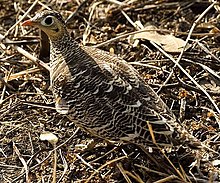Flying chickens
| Flying chickens | ||||||||
|---|---|---|---|---|---|---|---|---|

Sand grouse, pike wing grouse (♂ + ♀), desert grouse |
||||||||
| Systematics | ||||||||
|
||||||||
| Scientific name of the order | ||||||||
| Pteroclidiformes | ||||||||
| Huxley , 1868 | ||||||||
| Scientific name of the family | ||||||||
| Pteroclidae | ||||||||
| Bonaparte , 1831 |
Flight chickens (Pteroclidae) are ground birds in 16 kinds desert steppe and semi-desert Eurasian and Africa inhabit. The members of this family are very uniform in appearance, behavior and reproductive biology.
features
Grouse are the size of a partridge to a pigeon and weigh 150 to 400 g, have short beaks, short legs, a round body and a small head. Some species (such as the black grouse) have elongated feathers on their wings and tails. In adaptation to their surroundings, their plumage is kept in brown and green tones, predominantly sand and ocher colors with black ribbons and polka dots. The legs are feathered, as are the toes of the steppe chickens.
habitat
Grouse prefer desert areas as habitat, but are not exclusively tied to deserts . The Madagascar black grouse lives in the green hilly landscape of the eponymous island, while the brown-bellied black grouse lives mainly near the water.
Way of life
Since the great birds prefer areas with very high temperatures and little or no shade and feed mainly on seeds ( legumes ), they have to drink regularly. They live nomadically, some also switch seasonally between breeding and winter areas, e.g. B. Yellow-throated grouse and Senegal grouse . At dusk they look for water in large swarms that can be up to 50 km away. The males of breeding pairs crouch up to their belly in the water holes and swing their bodies back and forth. Her abdominal plumage soaks up with water. With this, the male flies back to the nest and lets the young suck the water out of the plumage. The birds' nests are small hollows that are hardly padded. The female lays around three eggs two to three times a year, which are incubated by both parents. The breeding season is 21 to 23 days.
Systematics
The systematics of the sea chickens was controversial for a long time. So they were by zoologists of the order of waders , chicken or pigeon birds assigned because their appearance and some behaviors ( ground-nesting birds , precocial , beak shape) of chicken birds such as partridges and rock partridges remember. The manner of flight and some anatomical details, on the other hand, seem to associate the birds with the pigeons , while other features such as the lack of wax skin, the structure of the skull or the anatomy of the digestive tract are more reminiscent of wading birds . Today they form their own order . The only family of this order are the flying fowl, Pteroclidae. The following genera and species can be found in this family:
- Family Pteroclidae, flying fowl
- Genus Syrrhaptes , steppe chicken
- Steppe Grouse , S. paradoxus
- Tibetan steppe chicken , S. tibetanus
- Genus Pterocles , actual flying fowl
- Subgenus Pterocles
- Northern black grouse , P. alchata
- Spotted butterfly , P. burchelli
- Red grouse , P. coronatus
- Masked black grouse , P. decoratus
- Brown-bellied fruit winged grouse , P. exustus
- Yellow-throated grouse , P. gutturalis
- Nama grouse , P. namaqua
- Sandfly , P. orientalis
- Madagascar grouse , P. personatus
- Three-banded grouse , P. quadricinctus
- Senegal grouse , P. senegallus
- Subgenus Nyctiperdix
- Striped butterfly , P. lichtensteinii
- Double-banded grouse , P. bicinctus
- Indian grouse , P. indicus
- Subgenus Pterocles
- Genus Syrrhaptes , steppe chicken
literature
- GL Maclean, GH Fry: Pteroclidae, sandgrouse. In: Emil K. Urban , C. Hilary Fry; Stuart Keith (Ed.): The Birds of Africa II. Academic Press, Harcourt Brace Jovanovich, London a. a. 1986, ISBN 0-12-137302-9 , pp. 422-441.
- E. de Juana: Family Pteroclidae (Sandgrouse). In: Josep del Hoyo , Andrew Elliott, Jordi Sargatal (eds.): Handbook of the birds of the world. Volume 4, Lynx Edicions, Barcelona, ISBN 84-87334-22-9 , pp. 30-59.


